Multiple Choice
Identify the
choice that best completes the statement or answers the question.
|
|
|
The Persecution
Begins
On April 4, 1933,
barely three months after Hitler took power in Germany, he ordered all "non-Aryans" to be
removed from government jobs. This order was one of the first moves in a campaign for racial purity
that would become the Holocaust-the systematic murder of 11 million people across Europe, more than
half of whom were Jews
WHY THE JEWS?
Although Jews were not the only victims of
the Holocaust, they were the center of the Nazis' target . Anti-Semitism, or hatred of Jews, had
deep roots in European history. For decades, many Germans looking for a scapegoat, or someone to
blame for their failures and frustrations, had targeted the Jews . As a result, when Hitler blamed
the Jews for Germany's defeat in World War I and for its economic problems following the war,
many Germans were more than ready to support him
As the Nazis tightened their hold on Germany,
their persecution of Jews increased. In 1935, the Nuremberg Laws stripped Jews of their civil rights
and property if they tried to leave Germany. To make identification easier, Jews over the age of six
had to wear a bright yellow Star of David on their clothing | 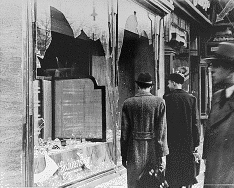
Kristallnacht
Worse was
to come. On November 9, 1938, a night that came to be known as Kristallnacht, or "crystal
night"-the night of broken glass-gangs of Nazi storm troopers attacked Jewish homes, businesses,
and synagogues across Germany. An American who witnessed the violence in Leipzig wrote, "Jewish
shop windows by the hundreds were systematically and wantonly smashed. . . . The main streets of the
city were a positive litter of shattered plate glass." Afterward, the Nazis blamed the Jews for
the destruction. More than 20,000 Jews were arrested and sent to concentration camps. At the same
time, a German official announced, "The Jews will pay a collective fine of one billion marks, 20
percent of their property." | | |
|
|
|
1.
|
What were the laws called that
took away the civil rights of the Jews?
a. | Berlin
Doctrine | c. | Nuremberg
Laws | b. | anti-Semitic laws | d. | Nazi Laws |
|
|
|
2.
|
When did hatred of the Jews
start in Europe?
a. | 1910 | c. | throughout European
history | b. | World War I | d. | 1930 |
|
|
|
3.
|
What did they call November 9,
1938 when Jewish shops were destroyed throughout Germany and Jews were harassed
a. | Kristallnacht | c. | Nuremberg Night | b. | Storm Trooper Night | d. | Anti-Semitic Night |
|
|
|
4.
|
Who did the Nazi’s blame
for the night of the broken glass?
a. | out of control
teens | c. | the
Jews | b. | the Communists | d. | the Brown Shirts |
|
|
|
THE PLIGHT OF JEWISH
REFUGEES
| Beginning in 1933, tens of thousands of
Jews fled Germany each year. After Kristallnacht, the Nazis tried to speed Jewish emigration but
encountered difficulty. France already had 40,000 Jewish refugees and did not want more. The British,
who were already admitting about 500 Jewish refugees a week, worried about fueling anti-Semitism if
that number were to increase . Late in 1938, Germany's foreign minister observed, "We all
want to get rid of our Jews. The difficulty is that no country wishes to receive them
."
| | |
About 60,000
refugees-including such distinguished people as physicist Albert Einstein, author Thomas Mann,
architect Walter Gropius, and theologian Paul Tillich-fled to the United States . More could have
come if the United States had been willing to relax its strict immigration quotas . This was not done, partly
because of widespread anti-Semitism among Americans and partly because many Americans feared that
letting in more refugees during the Great Depression would mean competition for scarce
jobs.
After war broke out in Europe in 1939, Americans also feared that opening the door
to refugees from Germany would allow "enemy agents" to enter the United States . President
Roosevelt said that while he sympathized with the Jews, he would not "do anything which would
conceivably hurt the future of present American citizens ."
Official indifference to the
plight of Germany's Jews was so strong that when the St. Louis-a German luxury liner filled with
refugees passed Miami in 1939, the Coast Guard followed it to prevent the passengers from attempting
to leave the ship for the United States . This decision was made even though 740 of the liner's
943 passengers had U.S . immigration papers . Passenger Liane Reif-Lehrer, who was just four years
old at the time, recalled, "My mother and brother and I were among the passengers who survived,
about a fourth of those on the ship. We were sent back to Europe and given haven in France, only to
find the Nazis on our doorstep again a few months later."
|
|
|
5.
|
The Nazi’s tried to
deport Germany’s Jews. Why did they have trouble doing so?
a. | It was too hard to get them to the
U.S. who had agreed to take them | c. | There were not enough trains to do so | b. | No other countries wanted
them | d. | The concentration camps were
full |
|
|
|
6.
|
What reason did Roosevelt give
for not allowing more Jews to enter the U.S. after war broke out in Europe
a. | he did not want to anger the
Germans | c. | he said that
America was a Christian nation | b. | he said we already had too many Jews | d. | he was afraid it would opened the door for foreign agents to enter the
U.S. |
|
|
|
7.
|
What did the St. Louis-a German luxury liner situation show ?
a. | Cuba and the United States hated the
Jews | c. | North and South America did not care
about the Jews | b. | The world though the Jews deserved what they were getting from the
Nazi’s | d. | North and South America were afraid
of the Nazi’s |
|
|
|
8.
|
In addition to anti-semitisim,
what other reason did Americans have for not wanting additional immigrants in the
country?
a. | Americans thought the Jews might
spread their religion | c. | Most Americans
supported Hitler | b. | Americans were afraid that Jews might take jobs away from
Americans | d. | Americans were afraid that Germany
would open concentration camps in the U.S. |
|
|
|
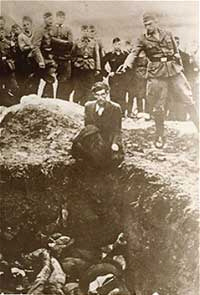 | The Final Solution
Unable to rid Germany of its Jews by forcing them to
emigrate, the Nazis adopted a new approach following Kristallnacht . Jews healthy enough to work were
sent to labor camps to perform slave labor. The rest would be sent to extermination camps. This
horrifying plan amounted to genocide, or the deliberate and systematic killing of an entire people
.
THE CONDEMNED
The Nazis' "final solution" rested on their
belief that "Aryans" were a superior people and that the strength and purity of this
"master race" must be preserved. To accomplish this, the Nazis condemned to slavery and
death not only the Jews but other groups that they viewed as inferior or unworthy or as "enemies
of the stat
| After taking power in 1933, the Nazis had concentrated on
silencing their political opponents-Communists, Socialists, liberals, and anyone else who spoke out
against the government. Once the Nazis had eliminated these enemies, they turned against other groups
in Germany. In addition to Jews, these groups included
" Gypsies-whom the Nazis believed to be an
"inferior race"
" Freemasons-whom the Nazis charged to be supporters of the
"Jewish conspiracy" to rule the world
" Jehovah's Witnesses-who refused
to join the army or salute Hitler
The Nazis also targeted other Germans whom they found unfit
to be part of the "master race," such as homosexuals. Beginning in 1939, the German
government rounded up these individuals and shipped them off to "special treatment"
centers, where they were "accorded a mercy death." By 1941, children near one of these
centers had become so used to seeing the special buses that were used to transport victims that they
would call out to each other, "Look, there's the murder box coming again."
As
the Nazis moved eastward, they added Poles, Ukrainians, and Russians to their growing list of
Untermenschen, or "subhumans," who were standing in the way of the expanding "master
race." After the invasion of Poland, for example, hundreds of thousands of Poles were killed or
shipped to Germany to perform slave labor. The emptied Polish towns and farms were resettled with
Germans seeking lebensraum | | |
|
|
|
9.
|
What is the formal name for killing an entire race or nation of
people?
a. | Kristallnacht | c. | genocide | b. | emigration | d. | pesticide |
|
|
|
10.
|
Why did the Nazi’s
imprison homosexuals, the mentally retarded, the insane, the disabled, the
incurably ill and the Jews?
a. | They believed they were costing the
German economy too much money | c. | They wanted to maintain the purity of the Aryan
race | b. | They thought these groups could become spies for
Britain | d. | These groups would not join the Nazi
party. |
|
|
|
11.
|
The Jehovah's Witnesses are Christians. Why were they sent to concentration
camps?
a. | They would not say, “Heil
Hitler” | c. | They were
anti-German | b. | They were pro Israel | d. | They were different |
|
|
|
12.
|
Which statement below would
compare to a statement a Nazi might make?
a. | There are no good
Jews | c. | We must maintain the purity of our
race | b. | Your group is responsible for the problems of my
group | d. | All of these attitudes are typical of Nazi
attitudes |
|
|
|
13.
|
Why did the Nazi’s create
the “Final Solution” to the Jewish problem?
a. | they were unable to get all of the
Jews to emigrate to other countries | c. | The Jews refused to serve in the German
military | b. | they did not want to use the Jews as slave labor in German
factories | d. | the Jews were lazy and just wanted
to attend school |
|
|
|
14.
|
The Nazi’s deported Jews
from Germany to other countries in Europe. But as they conquered these European countries the Jews
ended up in German territory again. What was the plan called to rid Europe of all
Jews?
a. | Kristallnacht | c. | The Genocide Plan | b. | The Final Solution | d. | Mien Kampf |
|
|
|
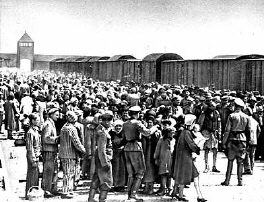 | CONCENTRATION CAMPS
The Nazis began implementing their "final solution" in Poland. Nazi
murder squads were assigned to round up Jews, strip them of their clothing, and then shoot them in
cold blood. Other Jews were herded into dismal ghettos, or Jewish sections, in Polish cities
and were left to starve or die from disease . Still others were dragged from their homes and herded
into trains and trucks for shipment to concentration camps. In this process, families were often
separated, sometimes forever |
Life in the camps was a cycle of
hunger, humiliation, and work that only ended with death. The prisoners were crammed into crude
wooden barracks that held up to a thousand people each. They shared their crowded quarters- as well
as their meager meals of thin soup and occasional scraps of bread or potato-with hordes of rats and
fleas. Hunger was so intense, recalled one survivor, "that if a bit of soup spilled over,
prisoners would converge on the spot, dig their spoons into the mud and stuff the mess into their
mouths ."
The prisoners worked from dawn to dusk, seven days a week, until they collapsed
. Those too weak to work were killed. Some, like Rudolf Reder, endured. He was one of only two Jews
to survive the camp at Belzec, Poland. | | |
|
|
|
15.
|
What were sections of Polish
cities, were Jews were imprisoned called?
a. | urban war
camps | c. | slums | b. | city prisons | d. | ghetto’s |
|
|
|
16.
|
Which statement is true about
the concentration camps?
a. | if a Jewish person worked hard there
was a good chance he or she would survive the camps | c. | none of these statements are true | b. | only Jewish children were able to survive the
camps | d. | very few Jews survived the
camps |
|
|
|
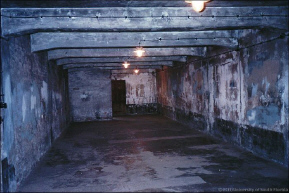 | EXTERMINATION
As deadly as overwork, starvation, beatings, and bullets were, they did not
kill fast enough to satisfy the Nazis. Late in 1941, the Germans built six death camps in Poland.
Each camp had several huge gas chambers in which as many as 6,000 lives could be snuffed out
daily.
| When prisoners arrived at Auschwitz, the largest of the
death camps, they had to parade by several SS doctors . With a wave of the hand, the doctors
separated those strong enough to work from those who would die that day. Both groups were told to
leave all their belongings behind, with a promise that they would be returned later. Those destined
to die were then led into a room outside the gas chamber and were told to undress for a shower. To
complete the deception, they were even given pieces of soap. Finally, they were led into the chamber
and poisoned with cyanide gas that spewed from vents in the walls. This orderly mass extermination
was sometimes carried out to the accompaniment of cheerful music played by an orchestra of camp
inmates who had temporarily been spared execution
At first the bodies were buried in huge
pits. At Belzec, Rudolf Reder was part of a 500-man death brigade that labored all day, he said,
"either at grave digging or emptying the gas chambers." But the decaying corpses gave off a
stench that could be smelled for miles around. Worse yet, mass graves left evidence of the mass
murder. At some camps, to try to cover up the evidence of their slaughter, the Nazis installed huge
crematoriums, or ovens in which to burn the dead. At other camps, the bodies were simply thrown into
a pit and set on fire .
Gassing was not the only method of extermination used in the camps.
Prisoners were also shot, hanged, or injected with poison. Still others died as a result of horrible
medical experiments carried out by camp doctors . Some of these victims were injected with deadly
germs in order to study the effect of disease on different groups of people. Others were forced to
exist only on seawater in experiments to determine how long shipwrecked seamen could survive . Many
more were used to test methods of sterilization, a subject of great interest to some Nazi doctors in
their search for ways to improve the "master race." | | |
|
|
|
17.
|
Why did the Jews march into the
gas chambers without protest?
a. | they did not go into the gas
chambers quietly | c. | they wanted to die
because there was no hope | b. | they thought they were going to take showers after the long train
trip | d. | they thought gas chambers were dining
rooms |
|
|
|
18.
|
It was possible to kill up to
____ persons a day in each death camp.
a. | 1000 | c. | 6000 | b. | 2000 | d. | 15000 |
|
|
|
19.
|
Which method did the
Nazi’s use to exterminate Jews in the concentration camps?
a. | gassing | d. | poison injections | b. | shooting | e. | all of these methods were used | c. | hanging |
|
|
|
20.
|
Why did the Nazi’s prefer
to burn the dead bodies of Jews in crematoriums?
a. | they wanted to get rid of evidence
of genocide | c. | they wanted to
insult the Jewish religion | b. | they used the ovens to create electricity | d. | they did not prefer to burn the dead bodies and left them to rot because it
was too much trouble |
|
|
|
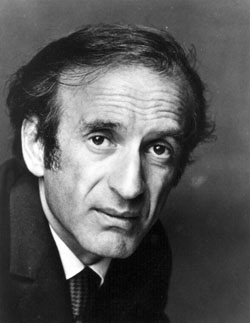
Elie Wiesel | THE
SURVIVORS
Six million Jews died in the death camps
and in Nazi massacres . But some miraculously escaped the worst of the Holocaust . Many had help from
ordinary people who were appalled by the Nazis' treatment of Jews. These people risked death by
hiding Jews in their homes or by helping them escape to neutral countries such as Sweden and
Switzerland .
Some Jews even survived the horrors of the concentration camps. In Gerda
Weissmann Klein's view, survival depended as much on one's spirit as on getting enough to
eat . "I do believe that if you were blessed with imagination, you could work through it,"
she wrote. "If, unfortunately, you were a person that faced reality, I think you didn't
have a chance." Those who did come out of the camps alive were forever changed by what they had
witnessed . For survivor Elie Wiesel, who entered Auschwitz in 1944 at the age of 14, the sun had set
forever. | | |
|
|
|
21.
|
About how many Jews died in the
Nazi death camps?
a. | 11
million | c. | 6
million | b. | 20 million | d. | 2 million |
|
|
|
22.
|
Most Jews who survived the
concentration camps were able to put it out of their minds and lead normal lives
|